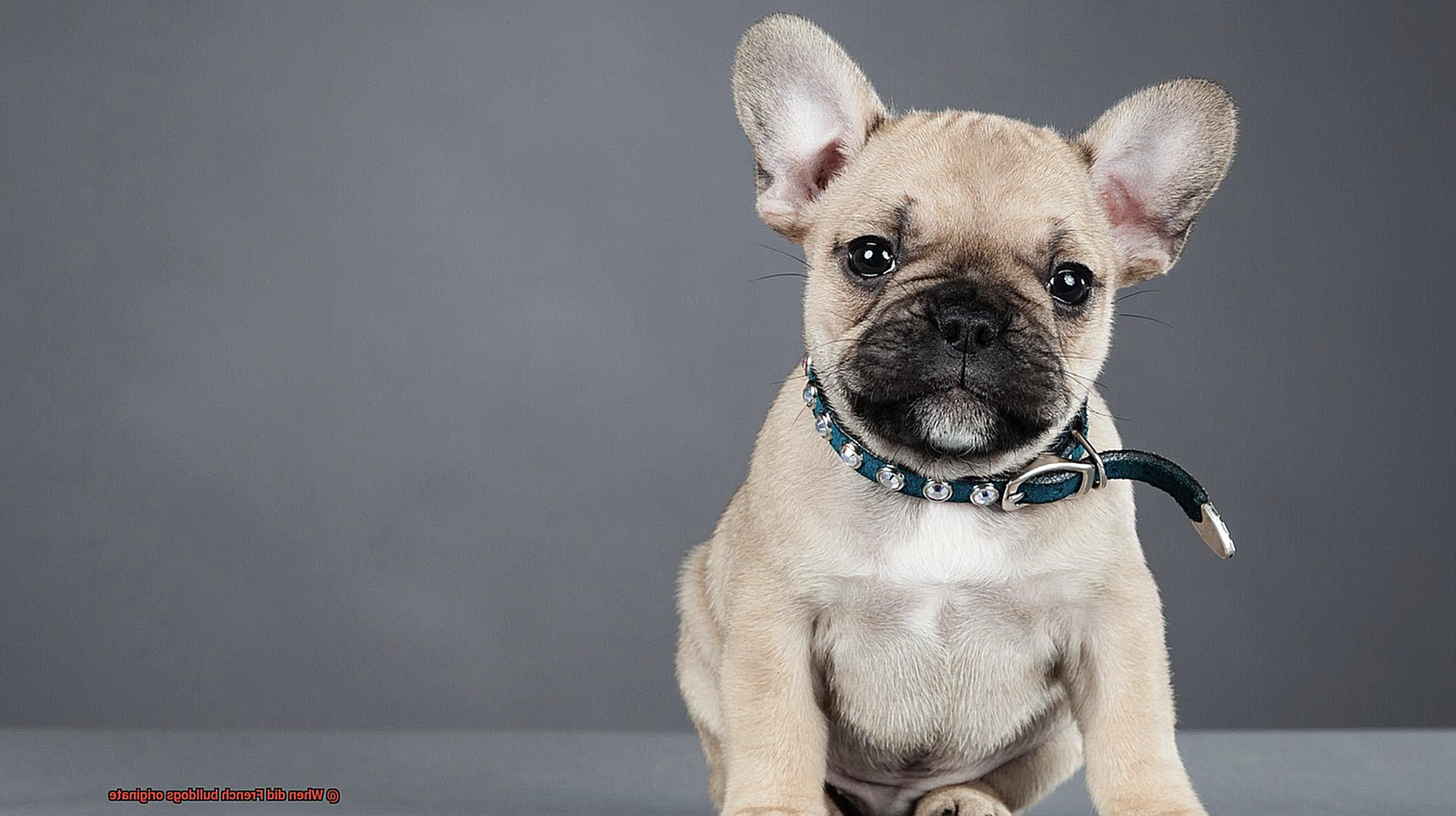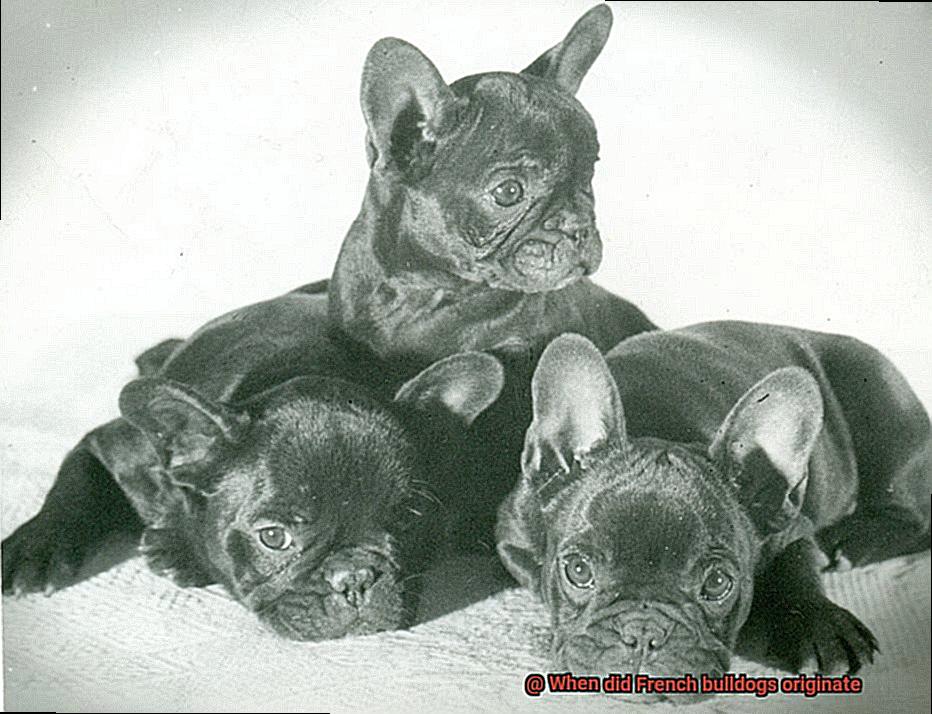When did French bulldogs originate?
Welcome to our blog, where we dive deep into the captivating world of French bulldogs.
If you’ve ever laid eyes on one of these adorable pups, you’ve probably found yourself pondering their origins. Well, ponder no more.
In this post, we’re embarking on a historical adventure to unravel the beginnings of French bulldogs and follow their path to the pinnacle of popularity they enjoy today. From their enigmatic roots in France to their irresistible charm and magnetic personalities, French bulldogs have captured the hearts of dog enthusiasts across the globe.

So, grab a steaming cup of joe, snuggle up in your favorite spot, and join us as we uncover the exact moment and place these beloved companions first burst onto the scene.

Origin of French Bulldogs in the 19th Century
Contents
- 1 Origin of French Bulldogs in the 19th Century
- 2 Descendants of the Toy Bulldog Breed
- 3 Migration and Industrial Revolution Impact on French Bulldogs
- 4 Popularity Among Parisian Society
- 5 Recognition by the French Kennel Club in 1898
- 6 Introduction of French Bulldogs to the United States
- 7 American Kennel Club Recognition in 1898
- 8 Global Popularity of French Bulldogs Today
- 9 Conclusion
Join me as we delve into the intriguing history of French Bulldogs in the 19th century, exploring their origins in France, the influence of lace workers in Nottingham, and the role of American breeders in popularizing this beloved breed.
The Industrial Revolution and Urban Living:
The Industrial Revolution brought about significant changes in society, including a shift from rural to urban living. As people moved to cities, they needed smaller dogs that were better suited for urban environments. This led to the crossbreeding of English Bulldogs with local terrier breeds, resulting in the creation of French Bulldogs.
The Lace Workers’ Connection:
The lace workers in Nottingham, England, played a pivotal role in the development of French Bulldogs. These skilled artisans faced unemployment due to mechanization during the Industrial Revolution and sought work opportunities elsewhere. Many migrated to France, bringing their beloved small Bulldogs with them. The unique characteristics of these dogs caught the attention of the French population and set the stage for the breed’s popularity.
The Rise of French Bulldogs in France:
In France, French Bulldogs quickly became a symbol of status and wealth among the Parisian bourgeoisie. These adorable canines were often seen accompanying fashionable ladies on their outings and even made appearances in artworks by renowned artists like Toulouse-Lautrec. Their endearing personalities and distinct appearance further solidified their place as beloved companions.
Breeding Programs and Recognition:
The breed underwent refinements over time to achieve its characteristic features, such as a compact body, bat-like ears, and a flat face. In 1887, the French Kennel Club officially recognized French Bulldogs as a purebred dog. This recognition paved the way for dedicated breeding programs and ensured the preservation of the breed’s distinct traits.
French Bulldogs in America:
The popularity of French Bulldogs extended beyond French borders when wealthy Americans visiting France fell in love with these charming companions and brought them back home. American breeders played a crucial role in promoting and developing the breed in the United States. In 1898, the American Kennel Club officially recognized French Bulldogs as a breed, further solidifying their place in American society.
Descendants of the Toy Bulldog Breed
The role of the Toy Bulldog breed in the development of the French Bulldog cannot be understated. These small and compact dogs were the ancestors of the French Bulldog and played a crucial role in shaping their physical characteristics and temperament.
Physical Characteristics:
The Toy Bulldog breed had a distinctive appearance, with a muscular body, flat face, and pushed-in nose. These traits were passed down to their descendants, the French Bulldogs, resulting in their iconic look. French Bulldogs also inherited the short and stocky build from their Toy Bulldog ancestors, making them a compact and sturdy breed.
Temperament:
The friendly and affectionate temperament of the Toy Bulldog breed was another trait that influenced the development of the French Bulldog. These dogs were known for their loyalty and companionship, which made them popular as lap dogs among ladies. This loving nature has been carried on by the French Bulldogs, making them excellent family pets and beloved companions.
Health Challenges:
While the Toy Bulldog breed faced health challenges, such as respiratory problems due to their short snouts, breeders of the French Bulldog have made efforts to address these issues through selective breeding. Although some health concerns still exist in the French Bulldog breed, responsible breeders are working diligently to minimize these risks and promote healthier individuals.
It is important to note that the Toy Bulldog breed became extinct in the late 19th century. However, its influence lives on through its descendants, the French Bulldogs. Breeders in France recognized the value of these small bulldogs and used them to crossbreed with other small breeds like terriers and pugs to create the foundation for the French Bulldog breed we know today.
Migration and Industrial Revolution Impact on French Bulldogs
French Bulldogs have become a beloved breed worldwide, known for their distinctive appearance and affectionate nature. But did you know that their origin and development were influenced by historical events like migration and the Industrial Revolution? In this blog post, we’ll explore how these events impacted the origin and growth of French Bulldogs, making them the adorable companions we know today.
Migration: Spreading the Breed Across Europe
The mass migration of craftsmen and workers from France during the late 18th and early 19th centuries played a vital role in introducing French Bulldogs to new regions. As these individuals settled in different countries, they brought their beloved bulldogs along, spreading the breed across Europe. This migration also led to crossbreeding with local dogs, resulting in further variations and adaptations of the breed.
Industrial Revolution: Urbanization and Changing Lifestyles
The Industrial Revolution brought about significant changes in lifestyle, particularly with urbanization and the rise of factory work. Workers moved from rural areas to cities, creating a demand for smaller-sized dogs that could adapt to apartment living. French Bulldogs, with their compact size and affectionate nature, quickly became popular companions for the working class during this time.
Refinement of Breed Characteristics

The demand for French Bulldogs during the Industrial Revolution led to further breeding programs aimed at refining the breed’s characteristics. Breeders focused on enhancing traits like the pushed-in nose, bat-like ears, and compact body. These features not only appealed to aesthetics but also served practical purposes in cramped urban environments.
Transportation Advancements: Spreading French Bulldogs Worldwide
The evolution of transportation during the Industrial Revolution also played a significant role in spreading French Bulldogs beyond Europe. Steamships and railways made it easier for people to travel, bringing their beloved dogs with them. This led to the introduction and breeding of French Bulldogs in other parts of the world, such as the United States.

Popularity Among Parisian Society
In the late 19th century, French Bulldogs started to gain popularity among the fashion-conscious Parisian society. With their charming personalities and distinctive appearance, these adorable canines quickly became a beloved choice for both the working class and the upper echelons of society.
From the Lace Makers to the Elite: A Versatile Breed
French Bulldogs initially found favor with the working class, particularly lace makers, who appreciated their small size and affectionate nature. These hardworking individuals often lived in cramped apartments, where larger breeds would struggle to find space. The French Bulldog’s compact size made them a perfect fit for this urban setting.
A Touch of Elegance on the Streets of Paris
As the breed’s popularity grew, they began to catch the eye of the wealthy and influential individuals in Paris. French Bulldogs soon became a fashionable choice among the elite, often seen accompanying fashionable ladies in the streets of Paris. These canine companions enhanced their social status and added a touch of elegance to their appearance.
The Unique Appeal of French Bulldogs
The French Bulldog’s unique appearance played a significant role in capturing the hearts of Parisian society. Their distinctive bat-like ears and compact bodies made them instantly recognizable and adorable. Artists and writers of this era often depicted French Bulldogs in their works, further solidifying their status as beloved companions of the Parisian elite.
Apartment Living Made Easy
Paris, known for its beautiful architecture and limited space, was a city where apartment living was common. French Bulldogs’ small size made them perfectly suited for this lifestyle. They could comfortably reside in smaller living spaces without compromising their well-being or happiness.
The Legacy Continues
The popularity of French Bulldogs among Parisian society continued throughout the 20th century and remains strong to this day. Their charm, adaptability, and affectionate nature have made them a cherished pet choice for both the working class and the elite.
Recognition by the French Kennel Club in 1898
In this blog post, we’ll explore how this recognition marked an important milestone and shaped the future of French Bulldogs.
Origins of the French Bulldog:
- The breed traces its roots back to English bulldogs brought to France by lace workers in the late 19th century.
- Crossbreeding with local terrier breeds resulted in the distinct features and smaller size of today’s French Bulldogs.
The Rise in Popularity:
- French Bulldogs quickly gained popularity among Parisian society due to their unique appearance and friendly temperament.
- The establishment of the first French Bulldog club in Paris in 1880 highlighted the growing interest in the breed.
Debate and Recognition:
- Despite their growing popularity, there was still debate about whether French Bulldogs should be classified as a distinct breed.
- The official recognition by the French Kennel Club in 1898 settled this debate and solidified their status as a unique breed.
Impact on Breeding Efforts:
- With official recognition, breeding efforts became more focused on maintaining and improving the breed’s characteristics.
- Breeders worked towards a standardized appearance, leading to the recognizable features we associate with French Bulldogs today.
Global Influence:
- The recognition by the French Kennel Club also had a ripple effect beyond France’s borders.
- French Bulldogs gained popularity in other European countries and eventually made their way to the United States, thanks to American tourists.
Continued Popularity:
- Today, French Bulldogs continue to captivate dog lovers worldwide with their charm and affectionate nature.
- Their recognition in 1898 set them on a path to becoming one of the most popular companion dogs globally.
Introduction of French Bulldogs to the United States
The Fascinating Introduction of French Bulldogs to the United States
Uncovering the Tale of French Bulldogs in America
Ah, the French Bulldog – a breed that has stolen the hearts of dog lovers across the United States. But have you ever wondered how these adorable snorting companions made their way to American soil? Let’s dive into the fascinating history of how French Bulldogs were introduced to the United States.
A Journey from England to France
Our story begins in 19th century England, where French Bulldogs were first bred as smaller versions of their English counterparts. These delightful companions were originally created to serve as loyal companions to lace workers in Nottingham. However, during the Industrial Revolution, these lace workers migrated to France, bringing along their beloved French Bulldogs.
Unleashing Their Charm on Parisian Society
In France, French Bulldogs quickly won the hearts of the upper class. Wealthy Parisians were often seen strolling through parks with these adorable bat-eared creatures by their side. The breed’s unique physical features and charming personalities made them instant favorites among the social elite.
A Transatlantic Voyage
It wasn’t long before French Bulldogs caught the attention of Americans traveling to Europe. These voyagers couldn’t resist the allure of these delightful dogs and brought them back home as treasured pets. And thus, French Bulldogs set paw on American soil for the first time.
Recognition by the American Kennel Club
In 1898, the American Kennel Club officially recognized the French Bulldog breed, marking their official introduction to the United States. This recognition solidified their status as a distinct breed and opened doors for breeding efforts to shape them into the lovable snorting companions we adore today.
Challenges and Triumphs
It wasn’t all smooth sailing for French Bulldogs in America. Limited breeding stock and high demand led to some unethical breeding practices, resulting in health issues within the breed. However, responsible breeders worked tirelessly to address these concerns and improve the overall quality of French Bulldogs.
French Bulldogs Today
Today, French Bulldogs are one of the most popular dog breeds in the United States. Their friendly and affectionate nature, combined with their unique appearance, make them excellent family pets. They bring joy, laughter, and endless snuggles to households all across the country.
American Kennel Club Recognition in 1898
Do you know how they became the pawsitively popular breed they are today? It all started with a significant milestone in 1898 when the American Kennel Club (AKC) recognized the French Bulldog breed. In this blog post, we’ll dive into the significance of this recognition and how it shaped the French Bulldog’s journey in America.
AKC: The Pawfessional Organization:
Let’s start by introducing the prestigious organization behind the recognition – the American Kennel Club (AKC). This pawfessional club registers purebred dogs and promotes responsible dog ownership. With their stamp of approval, breeds gain credibility, visibility, and a chance to compete in AKC-sanctioned events.
French Bulldogs: Before the Recognition:
Before 1898, our beloved French Bulldogs went by various names like Bouledogue Francais or Frenchie, but they weren’t officially recognized as a distinct breed. Despite their undeniably charming snorts and adorable bat-like ears, they needed that AKC recognition to solidify their status.
The Journey to Recognition:
The process of gaining AKC recognition isn’t a walk in the dog park. It involves dedicated breed clubs submitting detailed documentation about the breed’s history, characteristics, and population numbers. The AKC then conducts inspections and evaluations to ensure that the breed meets their standards for appearance, temperament, and health.
The Barktastic Impact of Recognition:
When the AKC finally recognized French Bulldogs in 1898, it was a game-changer. The breed gained validation for dedicated breeders who had been working tirelessly to promote and improve them. With AKC recognition, French Bulldogs gained credibility and attracted more enthusiasts and breeders.
Competing in the Big Leagues:
With their newfound AKC recognition, French Bulldogs could trot into AKC-sanctioned dog shows and events, strutting their stuff alongside other pawsome breeds. This increased visibility and competition opportunities helped showcase their exceptional qualities, catching the eye of dog lovers everywhere.
Preserving a Pawsome Heritage:
The AKC recognition also spotlighted the history and origins of French Bulldogs, reinforcing their unique qualities and distinct breed heritage. This recognition ensured that their charming snorts and lovable personalities would be preserved and celebrated for future generations to enjoy.
Global Popularity of French Bulldogs Today
Their unique characteristics, adaptability, and charming personalities have contributed to their global popularity. In this blog post, we will explore the factors that have made French Bulldogs one of the most sought-after dog breeds today.
Unique Characteristics:
French Bulldogs stand out with their compact size, distinctive bat-like ears, and wrinkled faces. These features make them instantly recognizable and adorable, attracting people from all walks of life. Their charm is irresistible.
Adaptability:
French Bulldogs are well-suited for various living conditions, making them a preferred choice for both apartment dwellers and those with spacious houses. Their adaptability to different environments has made them a popular choice for urban dwellers who may have limited space.
Friendly and Affectionate Nature:
French Bulldogs have a friendly and affectionate nature, which makes them excellent companions and family pets. Their loyalty and love for human interaction make them a perfect fit for families with children or elderly individuals seeking a devoted furry friend.
Low Exercise Requirements:
While regular exercise is important for their overall health, French Bulldogs do not require excessive physical activity like some other breeds. This makes them suitable for individuals with busy lifestyles or those who may not be able to engage in intense exercise routines.
Social Media Presence:
The rise of social media platforms has played a significant role in boosting the popularity of French Bulldogs. Many owners create dedicated accounts to showcase their adorable antics and unique personalities. These accounts gain large followings, further increasing the breed’s visibility and desirability.
Celebrity Influence:
Celebrities and influencers have also contributed to the global popularity of French Bulldogs. Well-known figures in the entertainment industry proudly own these charming dogs, creating a trend that influences others to consider adopting one themselves.
Accessibility:
French Bulldogs are widely available worldwide, thanks to dedicated breeders who meet the demand by providing healthy and well-bred puppies. This accessibility has made it easier for individuals from various regions to own a French Bulldog, further fueling their popularity.
Overall Health and Lifespan:
French Bulldogs generally have a relatively long lifespan compared to some other brachycephalic breeds. Their manageable health issues make them an attractive choice for prospective dog owners who prioritize the well-being of their furry companions.
JowI86FFQy4″ >
Conclusion
The French bulldog, with its distinctive bat-like ears and playful personality, has a fascinating origin story. This beloved breed can trace its roots back to 19th century France. It was during this time that lace workers from Nottingham, England migrated to France, bringing their small bulldogs with them. These dogs were bred with local French ratters and terriers, resulting in the creation of the French bulldog we know and adore today.
As the breed gained popularity among Parisian society, it quickly became a symbol of style and elegance. Artists such as Toulouse-Lautrec and Edgar Degas immortalized these charming canines in their paintings, further cementing their place in history.
However, it wasn’t until the late 1800s that the French bulldog made its way across the Atlantic to America. Wealthy Americans traveling to Europe fell in love with these pint-sized pooches and began importing them back home. The breed’s popularity soared, leading to the establishment of the French Bulldog Club of America in 1898.
Since then, French bulldogs have continued to capture hearts around the world. Their endearing snorts and affectionate nature make them perfect companions for individuals and families alike. Whether strutting down city streets or lounging on cozy couches, these delightful dogs are a testament to their rich history and enduring charm.
In conclusion, French bulldogs originated in 19th century France through a crossbreeding between English bulldogs and local French dogs. Their journey from lace workers’ companions to artistic muses and international favorites is a testament to their timeless appeal.




